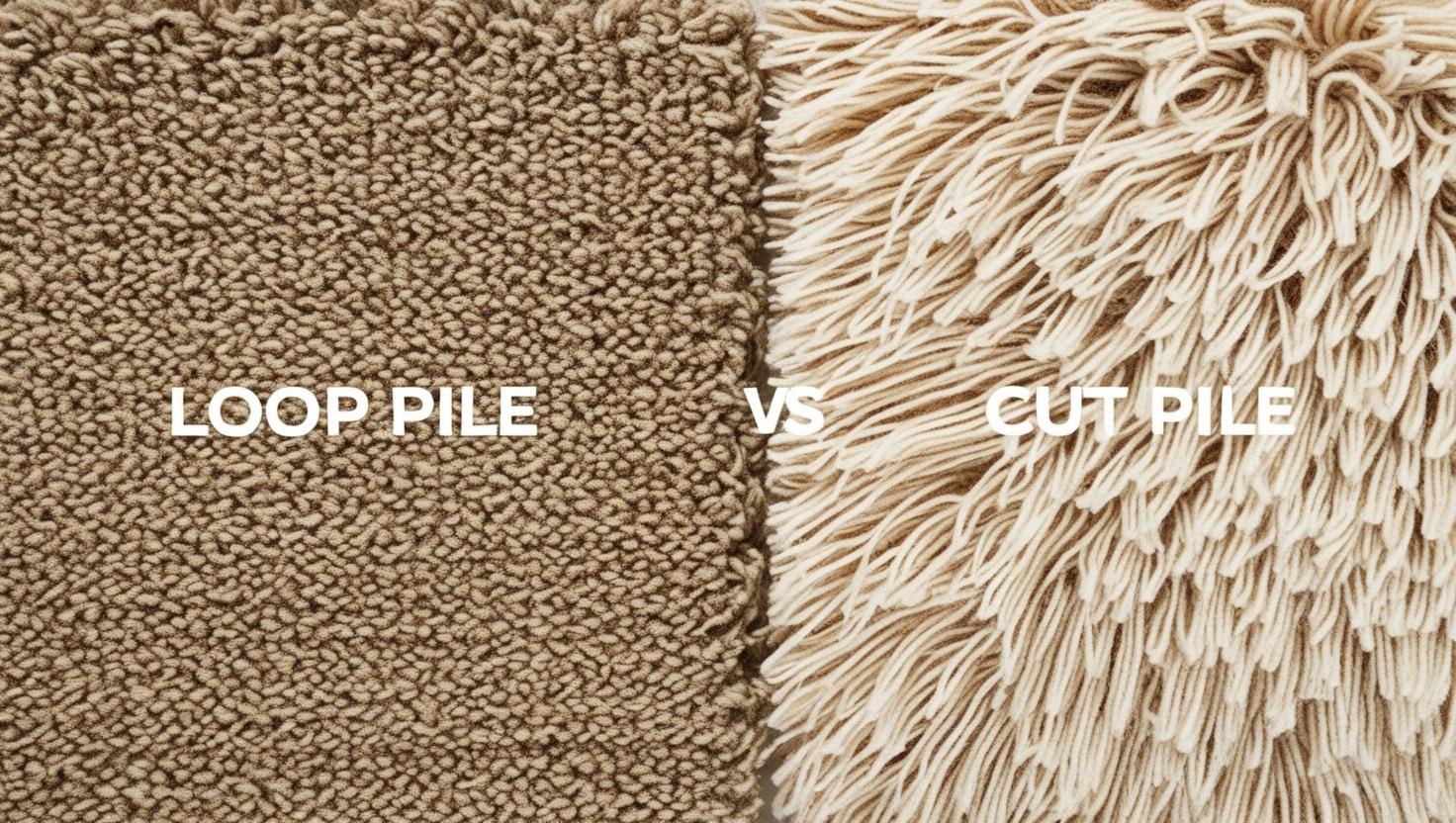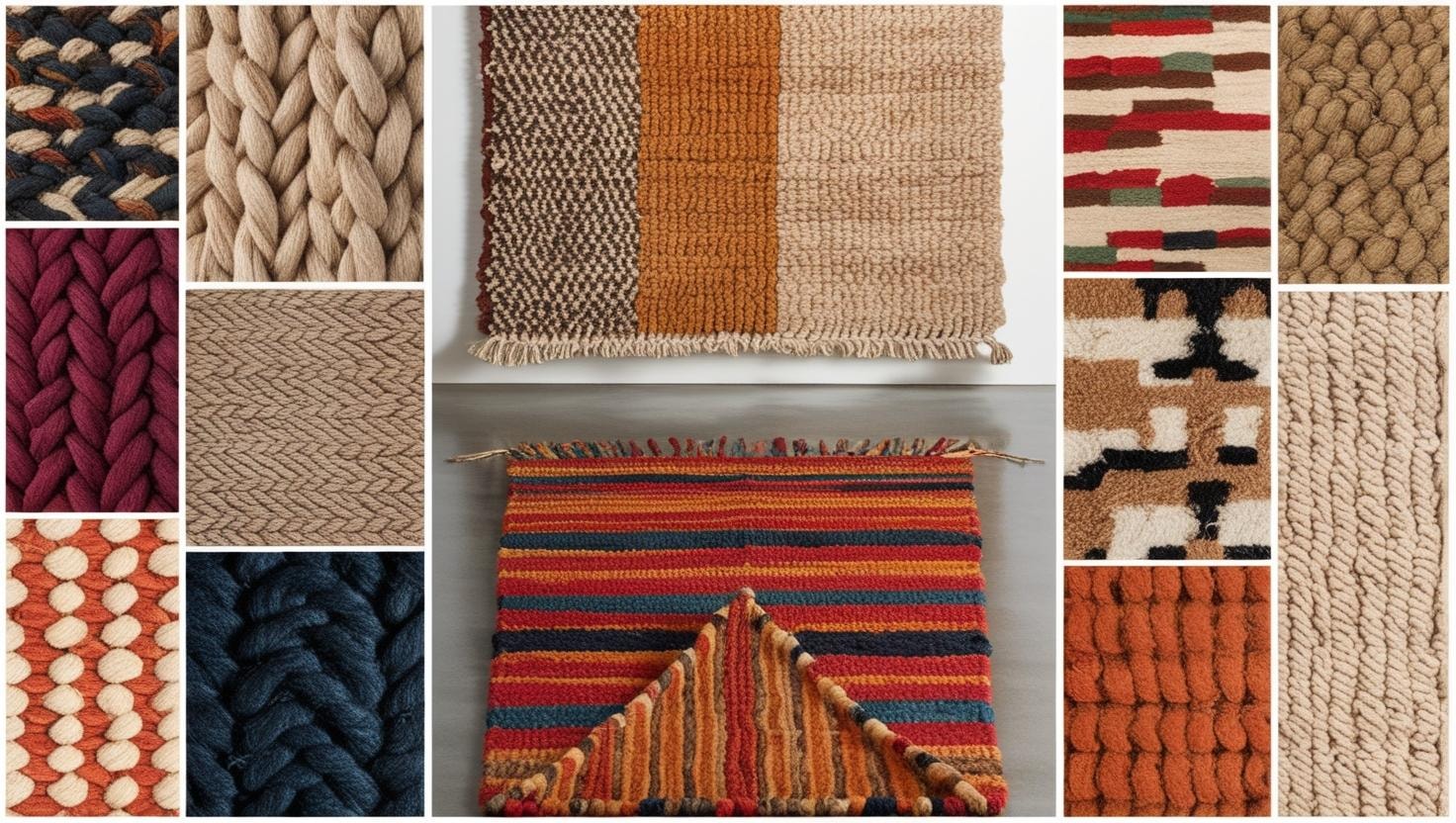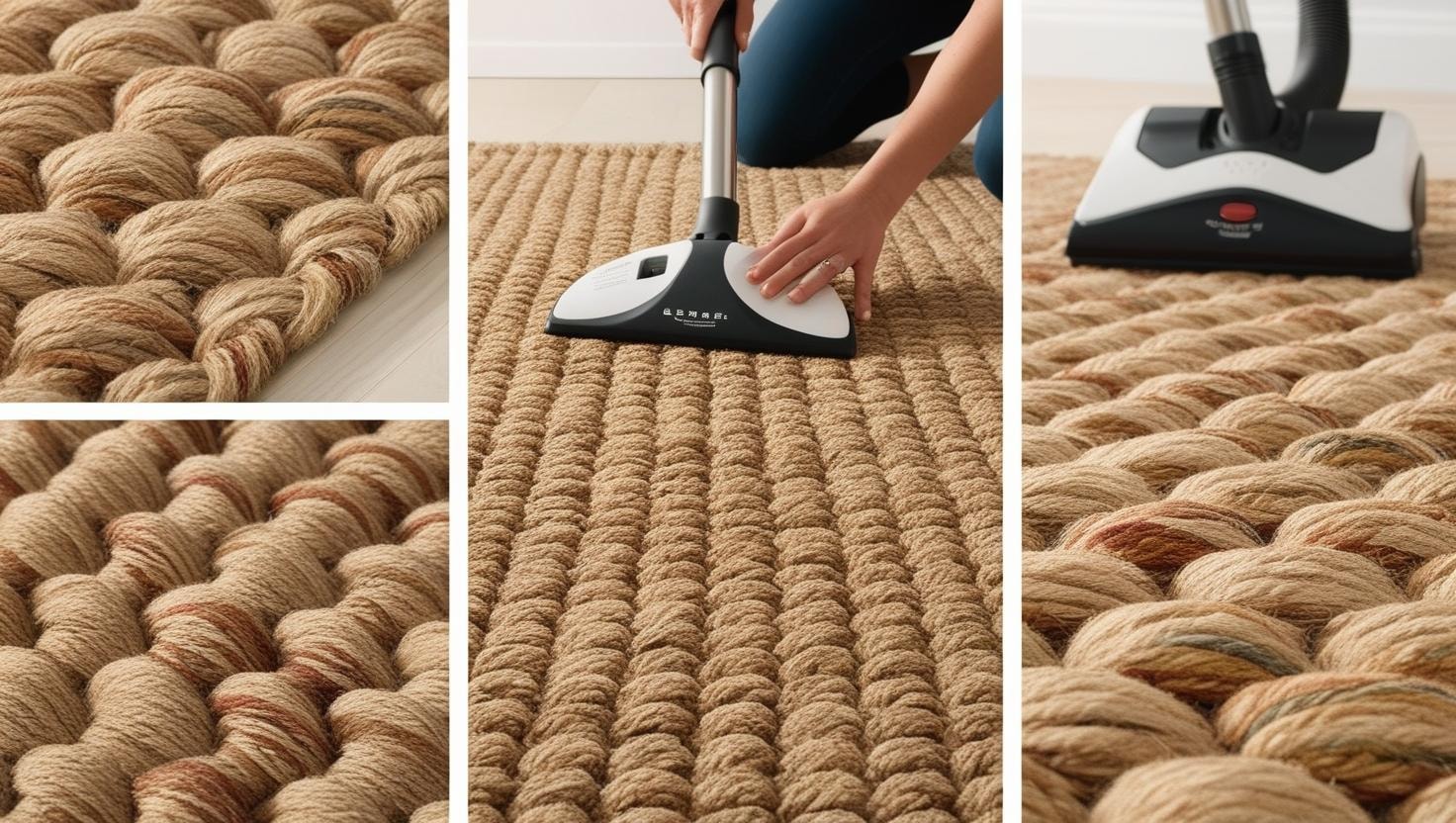Berber Loop Carpet is renowned for its resilience and distinctive style, which is derived from the traditional weaves of Berber tribes. This type of carpet features tightly sewn loops that enhance durability and resist foot traffic, making it an ideal choice for busy areas. Crafted from natural fibres like wool or synthetic nylon, Berber Loop Carpet provides a robust, soil-resistant surface while maintaining a sophisticated aesthetic. Its loop pile design differs from the cut pile by keeping the yarn loops uncut, pivotal in its ability to conceal dirt and withstand daily wear. Exploring further will uncover its suitability for various living spaces.
Berber loop carpet, characterised by its distinctive knot appearance and durability, stands out in the flooring industry due to its unique construction and historical roots. Originating from the weaving techniques of the Berber tribes, this carpet type integrates tightly sewn loops, which markedly differ from the cut pile carpets that feature fibres cut at the ends.
To fully appreciate the qualities and advantages of Berber loop carpet, it is essential to explore its texture, compare it with other styles such as cut pile, and consider its historical significance in textile design.
Understanding the unique texture of the Berber loop carpet involves recognising its tightly woven loops, which distinguish it from other carpet types primarily through its durability and distinctive feel underfoot. Berber loop carpets are crafted using a loop pile construction that involves a series of uncut loops. This structure not only enhances the robustness of the carpet but also contributes to its resilience and soil-hiding capabilities. The loop pile design of Berber carpets typically utilises fibres like wool, greatly enhancing their durability and aesthetic appeal.
The Berber loop carpet's texture is durable and versatile, making it suitable for high-traffic areas. The loop pile's density and construction prevent dirt penetration, simplifying maintenance and cleaning processes. Here's a comparative table to understand better:
| Feature | Berber Loop Carpet | Other Carpet Types |
|---|---|---|
| Construction | Tightly woven loops | Often cut-pile |
| Durability | High | Variable |
| Maintenance | Easier due to loops | More demanding |
Given these attributes, the loop pile carpet, particularly the wool carpet variants within the Berber loop category, stands out for its robustness and longevity, making it the top choice for both homes and businesses.
The origins of the Berber style, characterised by its loop pile construction, trace back to the weaving traditions of the Berber tribes. These Indigenous people crafted primarily utility-based textiles, favouring durability and functionality. Their woven fabrics' distinctive hand-knotted finish and resilient loop structures are hallmark features adapted into modern Berber loop carpets.
Berber loop carpets are renowned for their robustness and longevity. The loop pile technique involves looping yarn through the carpet backing, which can be made from various natural fibres such as wool or nylon, enhancing the carpet's durability. The styles are woven tightly, which prevents the loops from unravelling, thereby maintaining the carpet's structural integrity over time.
The carpets maintain aesthetic appeal with a minimalistic yet sophisticated look, making them suitable for residential and commercial spaces. The looped design contributes to the carpet's long-lasting nature, resists staining, and offers ease of maintenance, attributes highly valued in today's fast-paced world.

To differentiate between loop pile and cut pile carpets, it is essential to understand their respective constructions and the resultant differences in texture, durability, and appearance. Loop pile carpets, such as those commonly seen in Berber styles, utilise a loop construction where yarns are looped and secured into the backing. This densely woven loop formation enhances the carpet's ability to withstand high-traffic areas, making it particularly suitable for commercial environments and busy household spaces. The height of the loops can vary; generally, the lower the loop, the more durable the carpet.
In contrast, cut pile carpet involves cutting the yarn tips so that no loops are left, creating a plush, soft surface. This style is favoured for its luxurious feel underfoot, though it may not perform as well under extensive foot traffic as loop pile carpets. Cut-pile is available in several styles, including Saxony, plush, and frieze, each offering a different aesthetic and texture.
While both carpet types provide distinct advantages, the choice between a loop pile, like a Berber used in active settings, and a cut pile carpet often depends on the specific needs for durability versus comfort and the intended use in residential or commercial spaces.
When evaluating Berber loop carpet, it's crucial to take into account both its advantageous properties and potential drawbacks.
This style of carpeting is praised for its durability and cost-effectiveness, making it an attractive choice for both residential and commercial environments.
However, specific attributes such as its susceptibility to snagging and challenges in stain removal warrant careful assessment for high-traffic areas or homes with pets.
Frequently selected for its strength and stylish design, the Berber loop carpet offers several advantages, including resistance to foot traffic and ease of maintenance. This type of flooring is particularly well-regarded for its hard-wearing nature, making it an ideal carpet choice for high-traffic homes or business areas.
Thanks to their intricate patterns and natural hues, Berber carpets are woven with a loop pile construction that can effectively conceal dirt and footprints. One of the standout features of Berber loop carpet is its stain resistance. Many Berber carpets are made from wool, a naturally stain-resistant material. This makes them more manageable and helps them maintain a clean appearance over time. Additionally, the unique weave of Berber carpets prevents dirt and spills from penetrating the surface, simplifying cleanup efforts.
The aesthetic variety available within Berber Loop carpets is vast, ranging from neutral flecked carpets that blend seamlessly with various decor styles to more vibrant designs that make a statement. These carpets also feature a full range of patterns that can enhance any floor's visual depth and texture.
Furthermore, the tight loops are beneficial in resisting snags from claws, making Berber loop carpets a practical choice for pet owners.
While Berber loop carpets are celebrated for their durability and visual appeal, they also have several potential disadvantages that warrant careful consideration. One key issue is their susceptibility to snags and pulls. The looped design, while robust in many environments, can catch and unravel when exposed to sharp objects or the claws of household pets. This risk necessitates a strategic approach when installing commercial carpets in areas prone to such hazards.
Furthermore, the choice of material, such as polypropylene carpet, while economically suitable and adept at reducing heat loss, may not offer the same quality and longevity as more premium fibres. This factor is critical when choosing a carpet that balances cost with performance. Additionally, Berber carpets with lower height and density may be more complex to clean effectively, as dirt and debris can embed deep within the loops, complicating vacuum and maintenance efforts.
Stains pose another challenge. The tight loop structure can hinder the complete removal of spills, requiring more specialised cleaning solutions and techniques. This aspect should be considered by those prioritising ease of maintenance in high-traffic areas, where different layering methods may also be necessary to preserve the carpet's aesthetic and functional qualities.
Berber carpet, renowned for its looped construction, combines exceptional durability with a stylish appearance, making it a preferred option for residential and commercial spaces. Mostly made from materials like wool or synthetic ones, Berber carpets are engineered to withstand heavy foot traffic, particularly in high-use areas such as hallways and living rooms. Their tightly looped nature resists stains and dirt and maintains its form under pressure, making it an ideal flooring for winter and beyond.
For those designing a modern family home or looking to upgrade their office space, Berber carpet serves as a resilient and stylish option. It's important, however, to take into account both the advantages and drawbacks of this flooring type to guarantee it suits the unique requirements of your space.
Here's an overview in a structured format:
| Pros | Cons |
|---|---|
| High durability and longevity | Can snag on sharp objects |
| Stain-resistant | Limited cushioning compared to other styles |
| Ideal for busy areas like hallways | Difficult to clean if dirt gets beneath the loops |
| Aesthetically versatile | Not as soft as some other carpet types |
Selecting the ideal carpet for your home involves understanding the specific demands of each space, from foot traffic to aesthetic cohesion.
For areas subject to frequent use, the durability and resilience of the carpet type must be prioritised to guarantee longevity and maintain appearance.
Additionally, the integration of colour and texture should complement the existing home décor, enhancing functionality and stylistic harmony.
Choosing the right carpet type for each room involves considering foot traffic, room function, and maintenance requirements. To aid in this selection process, read our guide, which provides a step-by-step approach to identifying the most suitable carpeting options. This guide will take you through the nuances of various carpet types, from plush piles to durable Berber loops, helping you make an informed decision.
Carpets vary widely in texture, durability, and aesthetic appeal. For instance, a soft, luxurious carpet might be popular for bedrooms where comfort and a gentle underfoot feel are paramount. In these spaces, the focus is on creating a restful environment, so opting for softer textures and calming colours can enhance the tranquillity of the room.
Conversely, a different approach might be required for a living room. This area often serves multiple functions and sees higher foot traffic, necessitating a more robust carpet solution. Here, a range of loop pile carpets is valued for their durability in high-traffic areas and environments. Yet, they are still available in various colours and styles to complement the existing decor and create a welcoming space.

When evaluating carpets for high-traffic areas, it is imperative to focus on materials and construction methods that offer durability and ease of maintenance. With its tight loop construction, Berber Loop Carpet is a prime candidate for these areas, including living rooms and stairs.
The loops in Berber carpets are looped and fastened to the backing, creating a sturdy finish that resists early wear and tear.
For high traffic zones, proper installation techniques and additional components like underlay, door bars, and grippers are essential. The underlay plays a significant role in extending the carpet's life by providing cushioning and support, thereby reducing the pressure on the carpet fibres.
Door bars help secure the carpet at room thresholds, and grippers hold it in place, preventing it from shifting under frequent foot traffic.
For those considering Berber Loop Carpet for high-traffic areas, it is advisable to obtain free samples to assess the texture and resilience of the material in your specific environment.
Our guide is full of insights on selecting the right type of carpet and essential accessories for peak performance and longevity in demanding spaces. Check out our guide for a thorough approach to carpeting in high-traffic areas.
In addition, integrating the right Berber Loop Carpet into your home requires careful consideration of colour and texture to guarantee harmony with your existing decor.
When selecting a Berber carpet, it's paramount to analyse the chromatic elements and tactile qualities of the room's function and aesthetic. For instance, a neutral-toned carpet might be superb for a new home office, providing a subtle backdrop that doesn't distract from work tasks.
To take you through the different applications, consider the use of darker or mixed-fibre carpets in high-traffic areas, as they adeptly mask wear and enhance durability. Conversely, lighter shades can open up a space and inject a sense of airiness, ideal for smaller or less frequented rooms.
The loop construction of Berber carpets adds a dimensional texture that can either complement a minimalist style or contrast with more elaborate decor schemes.
When planning your interior, subscribing to our exclusive email newsletter can offer regular insights and tips, helping you make informed choices.
For example, a Berber loop might be used in the kitchen to give a final hurrah to a renovation with its practical and stylish finish, truly embodying the love of the relaxed yet sophisticated ambience it brings to any space.
Maintaining the pristine condition of Berber loop carpet requires specific strategies to remove stains and enhance durability effectively. Regular cleaning using the appropriate techniques and products is essential to preserving this flooring option's unique texture and resilience.
Next, we will explore detailed cleaning tips and methods to guarantee Berber Loop carpets' longevity and aesthetic appeal.
To effectively remove stains from Berber loop carpet, promptly addressing spills with appropriate cleaning solutions and techniques is essential. Berber carpets, known for their dense looped fibres, can trap liquids and debris, making immediate action critical to prevent the stain from setting.
Utilising gentle yet effective cleaning agents will guarantee the longevity and appearance of your carpet.
Implementing these targeted strategies will help maintain the pristine condition of your Berber loop carpet, ensuring it remains a valuable and attractive part of your home décor.
Regular vacuuming with an adequately adjusted vacuum cleaner is essential for preserving both the durability and appearance of the Berber loop carpet. The unique structure of looped fibres in Berber carpets, which are tightly woven and may consist of various yarn densities, dictates a specific approach to vacuuming. Choose a vacuum with adjustable height options, ensuring the beater bar is set high enough to avoid snagging the loops, which can lead to unravelling and substantial damage.
In addition to routine vacuuming, periodic professional cleaning is recommended to remove embedded dirt that household vacuums may miss. This is particularly important in high-traffic areas where soil can accumulate and degrade the fibre integrity over time. When selecting a cleaning service, verify their experience with loop pile carpets to avoid aggressive techniques that could harm the loops.
Immediate attention to spills and stains is also crucial. Blotting rather than rubbing the spill is essential to prevent the liquid from getting pushed deeper into the carpet fibres. Use a cleaning solution recommended for synthetic fibres and test it on an inconspicuous area first to ensure it does not affect the carpet's colour or texture.
When evaluating the cost of Berber loop carpet in comparison to other carpet types, it is important to take into account a variety of factors that influence pricing.
One significant element is the choice of material, varying from natural wool to synthetic fibres, varying in cost and durability.
Understanding these cost determinants is essential for consumers and industry experts to make well-informed purchasing choices.

Considering various factors, the cost of Berber loop carpet generally falls within the mid-range price bracket compared to other carpet types, influenced by its unique construction and material quality. This type of flooring is known for its resilience and distinctive appearance, which play a significant role in its pricing structure.
Key aspects that impact the cost of Berber loop carpet include:
These factors collectively contribute to the cost dynamics of Berber Loop carpets within the flooring industry.
The Berber loop carpet sets itself apart with its durability, aesthetic appeal, and cost-effectiveness, making it a practical option for various residential and commercial settings.
While maintenance requires specific attention to prevent snagging and pilling, the longevity and resilience of this flooring type often outweigh these considerations.
Prospective buyers should weigh these attributes against their unique requirements to make a well-informed decision, ensuring compatibility with functional requirements and budgetary constraints.